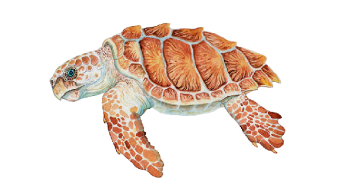
Loggerhead sea turtle
(Caretta caretta)
The Loggerhead sea turtle is one of the seven living sea turtle species of the world and is the most commonly encountered sea turtle in the waters of Madeira.
Sea turtles travel with the currents (such as the Gulf Stream) to Madeira and the Azores from nesting beaches along the coast of the Americas or the Cape Verde Islands.
They spend their years as juveniles travelling through the worlds oceans before returning the very same beach where they had hatched to breed. With the exception of hatching or nesting, sea turtles spend their whole lives in the ocean.
They come to the surface to breathe and warm up between their foraging dives, that can last up to 180 minutes. This resting behaviour, commonly known as basking, is also assumed to stimulate digestion and the sunlight is also thought to kill off the epibionts colonizing the turtles shell. In Madeira we mainly encounter juvenile turtles basking at the surface.
General information
Further names: Portuguese: Tartaruga-borba
Size of adults: Up to 1.2 m; can weigh up to 180 kg.
Prey: Young sea turtles are opportunistic feeders and eat everything that they can catch, mainly jellyfish and other gelatinous animals. As they grow, their feeding habits change. Adult animals feed on crustaceans and mussels.
Habitat and range: The tropical and subtropical oceans of the world.
Distinctive features: Their colour is reddish brown. Their blocky head, larger jaws and five instead of four pairs of rib plates distinguish them from the similar-looking Hawksbill sea turtle.
Life cycle and behaviour: Males and females meet during breeding season to mate and females then return to their nesting beach to lay their clutch of ping-pong sized eggs. The sexes only meet during the breeding season. A clutch may contain up to 120 eggs, depending on the age and physical condition of the female. When the eggs are successfully laid, the female buries them beneath the substate and crawls back into the water. Females may lay more than one clutch per season. Females usually lay eggs every two to three years. Hatchlings emerge after 50 to 70 days of incubation, depending on the ambient temperature of the substrate. Right after hatching, the young have to fend for themselves they make their way into the water. Out of every 1,000 hatched juveniles, only one reaches the sexually mature age of 20-25 (age of maturity depends on distribution). These animals can live for up to 50 years or longer.
Taxonomy: Class: Reptilia (Reptiles); Order: Testudines (Turtles); Family: Cheloniidae (Sea turtles)
Threats: They are endangered and are on the Red List of Threatened Species. Their populations have declined drastically due to the collection of their eggs and fishing activity; a lot of turtles get entangled in trawling nets, drift nets and floating debris. Nesting beaches are often destroyed and surrounded by artificial light sources, which disorientate young hatchlings leading them away from the ocean. Sea turtles are unable to distinguish floating plastic waste from their natural prey, jellyfish.
